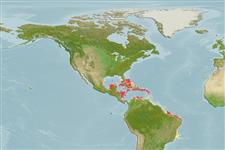>
Anguilliformes (Eels and morays) >
Ophichthidae (Snake eels) > Ophichthinae
Etymology: Aprognathodon: Name from Greek 'a' meaning without, 'pro' for forward, 'gnathos' for jaw and 'odontos' for tooth, referring to the lack of intermaxillary dentition.; platyventris: Name from Greek 'platy' for flat and 'ventris' for belly, referring to the flattened ventrum; noun in genetive case (Ref. 54133).
Environment: milieu / climate zone / depth range / distribution range
Ecología
marino asociado a arrecife; rango de profundidad 0 - 17 m (Ref. 54133). Tropical; 27°N -
Western Central Atlantic: Florida Keys, USA and Bahamas to Venezuela.
Tamaño / Peso / Age
Maturity: Lm ? range ? - ? cm
Max length : 46.0 cm TL macho / no sexado; (Ref. 7251)
Short description
Morfología | Morfometría
Vértebra: 148 - 152. Absence of raised platform between tubular anterior nostrils and median crease of the snout's underside. No teeth on anterior intermaxillary and vomerine. Anal fin present (Ref. 27478).
Found over shallow sandy bottoms with clear water (Ref. 5217).
Life cycle and mating behavior
Madurez | Reproducción | Puesta | Huevos | Fecundidad | Larva
Distinct pairing (Ref. 205).
Robins, C.R. and G.C. Ray, 1986. A field guide to Atlantic coast fishes of North America. Houghton Mifflin Company, Boston, U.S.A. 354 p. (Ref. 7251)
IUCN Red List Status (Ref. 130435)
Threat to humans
Harmless
Human uses
Más información
Age/SizeCrecimientoLength-weightLength-lengthLength-frequenciesMorfometríaMorfologíaLarvaDinámica larvariaReclutamientoAbundanciaBRUVS
ReferenciasAcuiculturaPerfil de acuiculturaRazasGenéticaElectrophoresesheritabilidadEnfermedadesProcesamientoNutrientsMass conversion
Herramientas
Special reports
Download XML
Fuentes de Internet
Estimates based on models
Preferred temperature (Ref.
123201): 26.4 - 28.2, mean 27.5 °C (based on 568 cells).
Phylogenetic diversity index (Ref.
82804): PD
50 = 1.0000 [Uniqueness, from 0.5 = low to 2.0 = high].
Bayesian length-weight: a=0.00089 (0.00039 - 0.00204), b=3.00 (2.80 - 3.20), in cm total length, based on LWR estimates for this (Sub)family-body shape (Ref.
93245).
Nivel trófico (Ref.
69278): 3.7 ±0.6 se; based on size and trophs of closest relatives
Resiliencia (Ref.
120179): Alto, población duplicada en un tiempo mínimo inferior a 15 meses (Preliminary K or Fecundity.).
Fishing Vulnerability (Ref.
59153): Moderate vulnerability (36 of 100).
